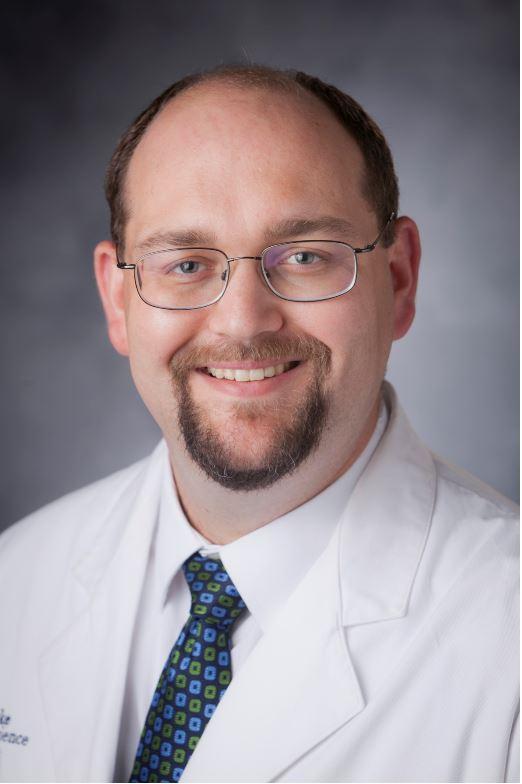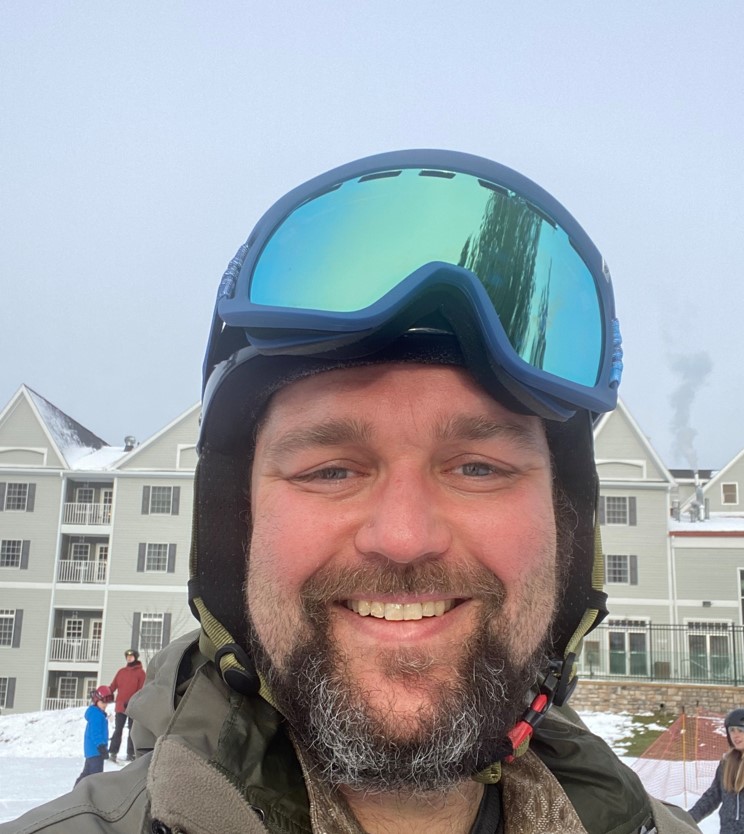
The growing specialty of hospital neurology has two hallmarks: complexity and diversity. One minute a hospital neurologist may be helping a cancer patient who is having a seizure; the next, they might be treating a recovering heart attack patient who has just had a stroke. Cases like these are the bread and butter for Hospital Neurology Division Chief Matthew Luedke, MD. In this week’s Faculty Spotlight interview, Luedke talks about the joys and challenges of seeing patients across our hospital system. He also discusses his recent research linking patient neighborhoods and their neurology health outcomes, his future plans for the Division, and enjoying woodworking, cooking, and other hobbies he’s not naturally good at when he’s away from Duke.
What are your current responsibilities within the Neurology Department? What does a typical day look like for you?
Clinically, I divide my time among the DUH consult service, the epilepsy clinic in Duke 1 L, along with some time in the epilepsy monitoring unit, on general neurology, and on occasion at Duke Raleigh and Duke Regional for coverage. It keeps me busy, but I love the diversity it offers me in my practice. Administratively, I am the Division Chief for Hospital Neurology. I have the privilege of working with the neurohospitalists and neurohospitalist APPs we have stationed at all three of the Duke Hospitals. It is an honor to work with some superb neurologists and to help coordinate part of Duke Neurology's inpatient mission across our health system.
How and when did you first get interested in neurology? What do you enjoy most about working in hospital neurology?
I fell in love with neurology as a med student. Had you asked me what I was going to be when I started medical school, there was no way I'd have said, "I want to be a neurologist when I grow up!" But, I had some superb pre-clinical teachers at Baylor College of Medicine, the late Drs. Robert Thalman and Frank Kretzer, along with the inimitable and recently retired Dr. Clay Goodman. Then, in my clinical rotations, I had some superb mentors, and that cinched the deal.
My favorite thing about hospital neurology is the diversity of problems that we see. As hospital patients get sicker, and they certainly have over the years, they're more vulnerable to neurological complications. A lot of what we see in the hospital are these neurological complications of general medical illness, so neurohospitalists are always encountering fascinating and challenging pathology generated by things like transplants, circulatory support devices, sepsis, cancer, and rheumatological conditions, just to name a few.
Throw in more "bread-and-butter" neurological conditions, like multiple sclerosis flares, seizures, or strokes, and hospital neurology becomes remarkably intellectually engaging field of practice. Plus, the pace is brisk, and for someone who is a little impatient, it's satisfying to order an MRI and get the results within the day, as opposed to ordering it and waiting a few weeks in clinic.
What are your top priorities for the Division of Hospital Neurology in the coming year?
We have some recruiting opportunities, which are job number one right now, and I'm excited about the candidates we have coming through. We're aiming to launch a hospital follow-up clinic to help ease transitions of recently discharged patients either back into the world of primary care or to offer them a bridge into more definitive neurology (sub)specialty follow up. Finally, we are engaged in developing a neurohospitalist fellowship.
The Neurohospitalist Society recently developed a credentialing process for fellowship programs, a real validation of the growing trend towards advanced training for hospital neurologists, particularly those working in tertiary care or academic settings. I think our department, which could offer exposure to trainees in three different hospital settings and a wealth of research and administrative-learning opportunities, would be a great place for fellows.
You contributed to a recent Neurology article that found that living in poorer neighborhood was associated with increased readmission rates and other poor neurologic health outcomes. What did you find to be the most important or surprising results of that study?
This study demonstrates compelling evidence that, at the neighborhood level, low socioeconomic status leads to poorer outcomes after hospitalization for several common neurological conditions. Interestingly, this outcome disparity persists even after accounting for individual economic status and comorbidities.
This suggests that there is something about the environment of low- socioeconomic status neighborhoods that is associated with increased risk. What that is remains unclear, though we posit two broad possibilities: either the patients in these environments have higher baseline risk of illness or exposure to more dangerous pathology/disease mechanisms; or, patients in low-socioeconomic neighborhoods may have different access to care or less access to protective community resources.
Perhaps more interesting is that 30-day readmission rates did not seem to be significantly impacted by neighborhood socioeconomic status. This was a little surprising and it's unclear why this may be the case.
How can providers (or hospitals) use this information to improve those disparities?
There is an old saw about thinking globally and acting locally. It's one thing to say that, broadly, socioeconomic status is associated with medical outcomes. But, to attribute this relationship to places you can identify on a map, in your own referral base, personalizes that understanding. It can potentially help plan for access and education initiatives for vulnerable neighborhoods, and, perhaps more importantly but more upstream, advocate at the local and state level for these communities to get more preventive and medical resources.
What’s the biggest change or development you see coming to hospital neurology (or neurology in general) over the next 5 to 10 years?
I think there are a few interesting trends. First, hospital neurology is the fastest growing subspecialty in neurology, and I suspect that trend will continue for the foreseeable future, though at some point that growth will plateau (there are only so many hospitals and so many neurologists). I think that there will be an evolving interrelationship between hospital and teleneurology, as hospitals grapple with the cost-benefit assessment of in-person hospital care.
Second, I think there will be an ambivalent trend towards subspecialization. As it stands now, neurohospitalists tend either to not have done a fellowship, or have a hodge-podge of fellowships like clinical neurophysiology, stroke, neurocritical care, among others. With the development of dedicated hospital neurology fellowships, I suspect it may be harder at some point for people to go straight into practice out of residency without any fellowship training, particularly at academic institutions, but I also think that the rapid growth in the field and recruiting pressures will blunt that trend, at least for the next few years.
What writing projects (if any) are you working on at the moment?
I’m currently working with our esteemed MS fellow, Dr. Kristen Veal, to finish a revision of a book chapter on neurological complications of kidney transplant.
What other passions or hobbies do you have outside of the Department?
I like to collect hobbies that I enjoy but I'm awful at. I like to (incompetently) do woodworking, fly fishing, and cycling. I'm a decent cook, and I have a mean recipe for banana bread. I also enjoy watching my kids do their favorite sports.
